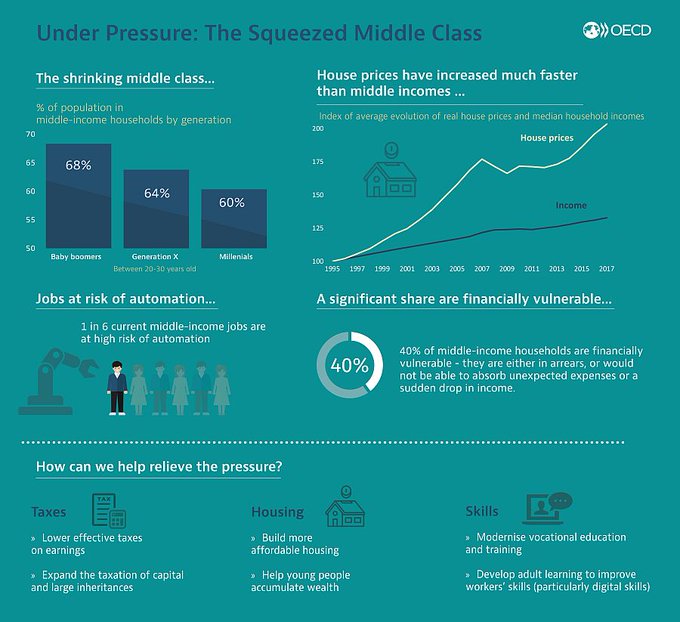The middle-class dream is moving beyond millennial reach

Do you feel like your cost of living is rising?
If so, you’re not alone. Years of low income growth and increasing prices have made the “squeezed middle” a reality for many, with new research showing young people’s prospects are among the hardest hit.
The middle class is shrinking in most countries and represents an out-of-reach dream for younger generations, according to the OECD’s report Under Pressure: The Squeezed Middle Class. Just 60% of millennials – people born between 1983 and 2002 – are part of middle-income households in their twenties, compared with almost 70% of baby boomers.

“The middle class used to be an aspiration,” the report says. “However, there are now signs that this bedrock of our democracies and economic growth is not as stable as in the past.”
A healthy middle class matters, not just for equality and inclusion, but also because it propels consumption growth and investment and generates tax income that helps fund social safety nets

1The OECD defines middle class as a range around the median household income, which varies from country to country. In the US, that’s between about $23,000 and $62,000, whereas in Mexico it’s about $4,000 to $10,000.

While the absolute amounts vary from country to country, the global patterns are clear: income growth is sluggish and the cost of goods and services associated with a middle-class lifestyle are increasing.
One in five middle-income households spend more than they earn, and over-indebtedness is higher for them than for both low-income and high-income households, the report says. In addition, automation and the Fourth Industrial Revolution have destabilized the labour market, creating uncertainty around job prospects and opportunities for many people.

These themes are echoed in the World Economic Forum’s Inclusive Development Index, which ranks economies using three pillars: growth and development, inclusion, and intergenerational equity and sustainability.

Norway tops the list, with low income inequality and high living standards, and the report cites its “robust and generous social safety programmes”. The UK ranked 21st and the US was 23rd.
“Slow progress in living standards and widening inequality have contributed to political polarization and erosion of social cohesion in many advanced and emerging economies,” the report says.
“This has led to the emergence of a worldwide consensus on the need for a more inclusive and sustainable model of growth and development that promotes high living standards for all.”
Government levers
Policy-makers need to recognize, prioritize and better measure inequality to maintain public confidence and raise living standards, according to the Forum. In a similar vein, the OECD says policies need to consider shifting the tax burden from labour income to income from capital, property and inheritance, as well as making income taxes fairer.

Listening to those at risk of being left out is also important. In 2011, Professor Klaus Schwab, Founder and Executive Chairman of the World Economic Forum, started the Global Shapers Community to empower young people and help them play an active role in shaping their future. In a survey, members of this community cited income as the second biggest contributor to inequality, after corruption.

Rocky waters
The OECD says a comprehensive action plan is needed, and one that improves access to high-quality public services and ensures better social protection. It also recommended that policies encourage the supply of affordable housing and offer financial support and grants.
“Today the middle class looks increasingly like a boat in rocky waters,” says OECD Secretary-General Angel Gurría. “Governments must listen to people’s concerns and protect and promote middle-class living standards. This will help drive inclusive and sustainable growth and create a more cohesive and stable social fabric.”



